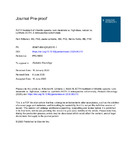ACTH treatment of infantile spasms: Low-moderate vs high dose, natural vs synthetic ACTH. A retrospective study

Files
Self archived version
final draftDate
2020Author(s)
Unique identifier
10.1016/j.pediatrneurol.2020.06.010Metadata
Show full item recordMore information
Self-archived item
Citation
Riikonen, Raili. Lähdetie, Jaana. Kokki, Hannu. (2020). ACTH treatment of infantile spasms: Low-moderate vs high dose, natural vs synthetic ACTH. A retrospective study. Pediatric neurology, 111, 46-50. 10.1016/j.pediatrneurol.2020.06.010.Rights
Abstract
Background
High dosages of natural adrenocorticotropic hormone are used in many centers in the United States for the treatment of infantile spasms. However, lower dosages of synthetic adrenocorticotropic hormone (tetracosactide) might be equally efficient as high dosages. We analyzed the treatment options for infantile spasms, especially regarding the adrenocorticotropic hormone dosage and the formulation (natural versus synthetic) and evaluated which options were more effective in a retrospective cohort from 1960 to 1976.
Methods
We compared the short-term response rates of patients treated with high dosages of natural adrenocorticotropic hormone (120 IU/day) (N = 31) (Group1) with those of patients treated with low-moderate dosages of natural adrenocorticotropic hormone (40 IU/day) (N = 52) (Group2). We also compared the short-term response rates of patients treated with natural adrenocorticotropic hormone (N = 83) with those of patients treated with synthetic adrenocorticotropic hormone, (N = 23) (Group3). The responses were evaluated clinically and by electroencephalography at two to three weeks after the onset of therapy.
Results
A response was seen in 24 of 31 children treated with high dosages and in 43 of 52 children treated with low-moderate dosages of natural adrenocorticotropic hormone (P = 0.56). All children with an unknown etiology responded to both high and low-moderate dosages of natural adrenocorticotropic hormone. The proportion of children with a good early response to synthetic adrenocorticotropic hormone (16 of 23) did not differ from the proportion of children with a good early response treated with natural adrenocorticotropic hormone (67 of 83) (P = 0.25).
Conclusions
High dosages of adrenocorticotropic hormone are not more effective than low-moderate dosages in the short term for treating infantile spasms. Synthetic adrenocorticotropic hormone is equally effective as natural adrenocorticotropic hormone.
Keywords
Link to the original item
http://dx.doi.org/10.1016/j.pediatrneurol.2020.06.010Publisher
Elsevier BVCollections
- Terveystieteiden tiedekunta [1793]


